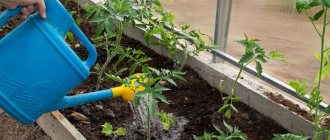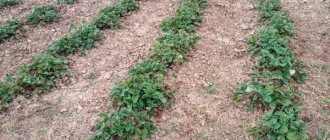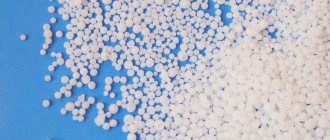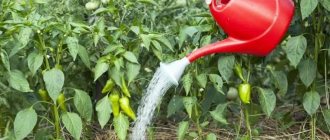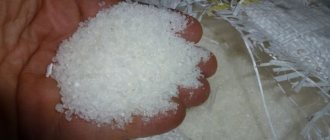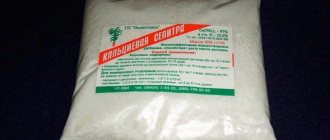Grain fertilizer as a fertilizer for plants - pros and cons
Fertilizing from bread is a very necessary and useful fertilizer, especially during the fruiting period. As already mentioned, the main useful component is yeast. These are single-celled fungi from the Saccharomyces family, which contain a huge amount of macro- and microelements, so they are used not only in cooking and cosmetology, but are widely used in gardening. They have a whole range of useful properties:
- Increases plant immunity to adverse weather conditions;
- Increase resistance to various infections;
- Accelerate the formation of the root system and strengthen it;
- Increase the vegetative mass of the plant;
- They are growth stimulants;
- The taste of vegetables improves and yield increases.
The action of yeast in the soil is the formation and reproduction of soil bacteria. Bacteria, in the process of their vital activity, process organic substances, resulting in the formation of nitrogen and potassium, important elements for the growth of any plant.
However, there is a drawback when using bread infusion as a fertilizer. Yeast reduces the calcium content in the soil. Therefore, in parallel with this feeding, it is necessary to add fertilizers containing calcium, for example, eggshells or wood ash. In addition, the fertilizer acidifies the soil, so it is more rational to use it on alkaline or neutral soil. And adding manure or chicken droppings to the infusion neutralizes the effect of yeast, so they should not be added when preparing the solution.
Bread infusion helps fight weeds. Having fertilized the bed in early spring, the remaining seeds germinate quickly. When forming the beds, the emerging weeds are removed and in the near future they will not appear again for a long time. You can fight weeds in the fall in a similar way.
Remember! When buying bread to feed plants, make sure it contains yeast. Bread with dyes or without yeast is not suitable for feeding.
Let's sum it up
Both dried and fresh products are suitable for bread feeding. Nutrient solutions are prepared on its basis. There are many recipes for making top dressing from bread. Most often, ash, iodine, hay and grass are used as additional ingredients.
Practice shows: bread infusion is especially effective for tomatoes if you add it three times. Better results can be achieved if you use it during periods when tomatoes are starting to set on the bushes and begin to ripen. The break between feedings is about two weeks. By following these simple rules, you will increase your tomato yield!
GARDEN HEAD. Bread food for plants
Recipe for making bread topping
For preparing the infusion, black or gray bread, as well as the remaining dry crusts from it, are better suited. Oven-dried or toasted crackers are not suitable for making infusion.
Fill 1 loaf into slices with 5 liters of warm water to speed up the fermentation process.
Pieces of bread float to the surface of the water so that they do not become moldy at the top during the fermentation process; the container is closed tightly with a lid so that the pieces are completely immersed in the water and do not fall out of the bucket. To do this, press the lid on top with a small weight.
Leave to ferment for 5-7 days. After a week, the infusion will be ready. Add water to a volume of 10 liters.
Before using the infusion, the pieces are crushed and the infusion itself is filtered. Bread cake can be spread under fruit bushes, and the infusion itself is used for root and foliar (leaf) feeding.
For information. In order to obtain better nutrition, weeds, such as nettle or dandelion, are added to the mixture.
Advice from professionals
Experienced vegetable growers never use bread infusion to feed sick, unrooted tomatoes. Beginner gardeners may find their advice useful:
- tomatoes growing in the shade are watered less frequently and less abundantly;
- do not feed tomatoes in the middle of the day if the weather is sunny and hot;
- bread sourdough brings more benefits to tomatoes growing in soil with an alkaline reaction;
- You need to add ash to the leaven made from crackers, 1 cup per bucket.
Bread infusion for cucumbers with iodine
There is probably not a single gardener who does not grow cucumbers on his plot. That is why the topic of feeding is important and always relevant. When feeding cucumbers with manure, very often the root system of the plants begins to hurt. As a result, various inclusions appear on the leaves, and the leaf blades along the edges begin to turn yellow. And the application of mineral fertilizers, especially during the fruiting period, leads to the accumulation of nitrates in the fruits.
Therefore, it is best to use natural organic fertilizers; even an excess of them cannot harm either the plant or the person. And one of the safest ways is to use bread infusion, or rather the yeast that is always in it.
The infusion is prepared according to the same principle, no matter what you want to use it for.
- 1 loaf or loaf of black bread is cut into slices or small pieces and soaked in 10 liters of warm water,
- The top of the container is closed tightly with a lid,
- Leave to brew for several days
- The infusion is filtered and it is ready for use.
Fertilizing of cucumbers is carried out every 2-3 weeks, they are especially necessary during the period of fruit set and fruiting. For greater efficiency, iodine is added to the infusion. Of course, they can do without it. Iodine is a very useful microelement that plants need. In addition to the fact that it has a beneficial effect on the growth and development of the plant, it also prevents the occurrence of various diseases on cucumbers. Also, when preparing fertilizer, ash is added.
Half a bottle (10 ml) of alcohol tincture of iodine is poured into the prepared infusion. Having added iodine, mix the infusion well, and then carry out foliar feeding, irrigating the leaves with the infusion from a sprinkler. For root feeding, 0.5-1 liters of solution is watered under each plant.
Thanks to grain fertilizer, cucumbers
- become more resilient to sudden weather changes.,
- less susceptible to diseases,
- their root system is strengthened and shoots become stronger,
- the growth of vegetative mass and the appearance of ovaries is accelerated,
- The taste and aroma of the fruits themselves improves significantly.
Recommendations for using fertilizer
Infusions of breadcrumbs (rye, wheat) are used throughout the growing season. A few useful tips will help make fertilizing more effective:
- During fermentation, bacteria release nitrogen and potassium, but calcium is actively washed out of the soil. To prevent a deficiency of this useful element, infusions of wood ash are added simultaneously with fertilizing the bread.
- Overdose of compounds is not allowed. Otherwise, it is quite possible to get plant oppression instead of increasing the green mass and root system.
- It is advisable to use rye bread for preparing infusions, although wheat bread will also work. Pieces of rolls, loaves, and black bread are dried, and only then infusions are prepared.
- Pieces of bread and crackers with mold formed on the surface are suitable for fertilizing. Mold fungi are not dangerous for vegetable and flower crops, so this bread is quite suitable for infusions.
- It is not allowed to use slurry, diluted mullein or bird droppings simultaneously with grain fertilizer.
- When bread ferments, a specific smell appears, so leave the containers in a remote place.
- When using bread infusions on acidic soils, it is recommended to add chalk or dolomite flour to the fertilizers. This will neutralize the acid and maintain the desired soil balance.
- After infusing the crackers, only liquid is used for feeding. The resulting cake is “sent” to the compost heap and is under no circumstances thrown away.
- It is not recommended to water weakened plants with infusion.
- Fertilizing is applied only to warm soil, in the late afternoon. You cannot water tomatoes or cucumbers in the heat, as this causes burns to the root system.
- For crops growing in shade and partial shade, bread infusions are not used due to their poor absorption.
Feeding tomatoes, peppers, eggplants with bread infusion
Try feeding your tomatoes, peppers, eggplants, and cabbage with bread infusion. Already on day 2-3 you will notice how the plants have noticeably changed for the better. It has been noticed that after introducing bread sourdough, the yield increases by 25%. Sourdough is useful as a source of yeast, which, when added to the soil, begins to release carbon dioxide, which is essential for plants to fully develop. After such feeding, the plants begin to grow rapidly and bear fruit well.
When preparing the fertilizer, fill the container 1/3 with crusts, fill it to the top with warm water and leave it to ferment in a warm place for a week. To improve the composition, weeds and mowed grass are added to the water. After a week, the infusion is filtered. The remaining grounds are placed under bushes in the garden, or in a compost heap. And 2 liters of the strained solution are diluted in a bucket of water (10 liters) and the plants are watered at the root, at the rate of 1-1.5 liters of solution per plant.
The first feeding is carried out before flowering by spraying the plant. The second, when fruiting begins, and here it is better to add 25 drops of iodine to the solution. This procedure increases fruiting and protects tomatoes from late blight.
Know that only white bread infusion is used to feed carrots.
When feeding plants, remember that the effectiveness of fertilizer will increase if you follow the following rules.
- Fertilizing is carried out after watering the plants with water, so all the beneficial substances from the infusion will quickly reach the root system;
- In order for beneficial substances, namely yeast, to begin to act, fertilizing is carried out in warm weather, or the soil must be warm;
- In order to improve fruiting, sifted ash or finely ground eggshells are added to the solution during the second feeding;
- It is better to fertilize in the morning or evening, every 2 weeks.
Reviews
In open sources - for example, on various thematic forums on the Internet - you can always read reviews from summer residents and gardeners who have already used such fertilizer.
Larisa Rybina, Samara: “When I was feeding my tomatoes with bread for the first time, the question arose of what to do with the soggy bread crusts left over from straining. A neighbor suggested adding them to the compost pile. I still do this, I haven’t found any other use.”
Darina, Tver: “For tomatoes, I add a little ash to the bread and herbal infusion. I water it at the root. They thank you with good harvests. Those bushes that I fertilized were pleased with larger fruits.”
Vasily Petrovich, Moscow region: “Last year I fed tomatoes with bread and yeast tincture five times during the season. The tomatoes started to get fat. I came to the conclusion that there is no need to overdo it. Everything needs moderation."
How to use bread fertilizer for strawberries
And bread fertilizer has a very beneficial effect on strawberries. After applying fertilizer, the foliage on the bushes and shoots become stronger. Plants are less likely to be exposed to diseases, primarily gray rot, and the berries grow large and sweet, and the yield increases noticeably.
The working solution is prepared using the same technology as when feeding other vegetables. The soaked bread is left to infuse for a week, then the infusion is filtered. The prepared solution is watered at the root of the plant, not forgetting that the soil should already be covered with water.
For information . Dilute the prepared infusion 1:10 if you have soaked the bread by a third or half the volume of the container. If you prepared a solution at the rate of 1 loaf of bread per bucket of water, in this case there is no need to dilute it, the solution is already ready for use.
- The first feeding is carried out with the onset of warm weather and after spring treatment of the bushes.
- Subsequent processing is carried out after the harvest is completed.
Remember that yeast reduces the calcium content in the soil, so add ash and eggshells to the infusion as a source of calcium. Or they are scattered between the bushes and then embedded in the soil.
Bread fertilizer for seedlings
In the middle zone, crops such as tomatoes, cucumbers, eggplants, and sweet peppers are grown through seedlings. Healthy and strong seedlings are the guarantee that the harvest will be high, and the same grain feeding will help achieve this.
To water the seedlings, barrels of fertilizer are not needed, so the recipe will be different:
- a loaf of black bread is crushed (or an approximate amount of crackers), poured into a large saucepan or tank;
- pour warm water (5 liters);
- cover with a lid and put in a warm place;
- the grounds are squeezed out and removed;
- the remaining infusion is filtered;
- for fertilizing, seedlings are diluted with clean water: a liter of infusion per 8 liters of water.
Plants in boxes or containers are watered twice, with a break of 10 days. Tomatoes are fed only after picking into separate containers.
On a note! Houseplants are watered with this bread infusion to stimulate flowering and improve growth. Fertilizers are applied only at the roots, being careful not to get on the leaves of seedlings and flowers.
The best way to grow seedlings is bread infusion
At the initial stage of plant development, when tomatoes, peppers, eggplants, and cucumbers are grown as seedlings, feeding them with bread infusion will be extremely useful. The seedlings will quickly respond to the fertilizer, since its root system will very quickly strengthen, which means the plant will receive all the substances it needs for growth.
Later, when the seedlings are transplanted to a permanent place, they will adapt faster and better to new conditions. In addition, it will be easier to resist various pathogens.
The solution is prepared as usual. First, the bread is infused for a week in water. Seedlings do not need a strong concentration, so the resulting solution is diluted in a ratio of 1:10. And with this solution the seedlings are watered 1-2 times a week. In a few days you will notice how your seedlings have grown stronger.
About the benefits of crackers
To prepare a nutritious infusion, crackers made from any yeast bread (white, gray) are suitable. It is yeast that has a positive effect on plants. When used regularly, they stimulate the growth of roots and above-ground parts of plants.
Gardeners who use an infusion of dry bread note its benefits for vegetable and flower crops:
- plants are actively growing already on the 3rd day after root feeding;
- vegetables can more easily withstand stress caused by worsening weather (heat, cold snap, prolonged rain);
- In tomatoes, the immunity and taste of the fruit improves, and productivity increases.
The secret of grain fertilizer
With root feeding, beneficial bacteria actively multiply in the soil, which, absorbing microelements (nitrogen, phosphorus, potassium) from the soil, convert them into compounds more accessible to plants.
Thanks to this, the nutrition of vegetables occurs more intensively. On a note!
They do not like bread kvass, garlic, onions, or potatoes.
Tomatoes are one of those vegetable crops that respond well to yeast feeding. To achieve results, they are fertilized at least 3 times:
- during the formation of buds for the first time;
- the second time after 2 weeks (at the beginning of the formation of the ovaries);
- the third time in another 2-3 weeks.
How to feed peonies, roses and geraniums with bread
Indoor and garden flowers are no less demanding of fertilizers. By receiving useful substances in fertilizing, they bloom better and longer. Peonies, roses, and chrysanthemums, that is, those flowers that have a rich vegetative part, respond especially well to grain feeding. Among the indoor plants you should feed are geraniums, violets, and gloxinia.
The solution is prepared in the same way as in previous cases. Whether or not to dilute the infusion depends on how much bread is soaked in 10 liters of water. The concentrated solution must be diluted at a rate of 1:10.
Fertilizer is applied in the spring during the period of growth of the vegetative mass, and in the summer, when the flowers begin to bloom. In parallel with grain fertilizing, calcium fertilizers or mineral fertilizers with a high calcium content are applied to the soil. As an alternative, adding wood ash or crushed egg shells and then embedding them into the ground is a good option.
When and why to use fertilizer
Tomatoes respond very well to fertilizing with black bread. If you fertilize them correctly and on time, the harvest will be rich and tasty. If the scheme and dosage are followed, the yield increases by almost 30%.
When using this type of food, there are several important rules to consider.
- To achieve the desired effect, fertilizing should be done in well-heated soil. Therefore, it is advisable to use it in the garden in summer or for plants grown in greenhouse conditions.
- Such feeding will be appropriate before fruiting begins. Adding it during the ripening period will not give any effect.
- For better absorption of nutrients, the soil is shed with water before adding the nutrient solution.
- To enhance the effect of the bread infusion, wood ash and ground eggshells are added to it - 1 tsp is used per liter of sourdough. each component.
- The recommended number of feedings per season is no more than three.
- It is best to water tomatoes in the evening, when the soil is still warm and the sun has disappeared below the horizon.
Feeding tomatoes with bread
Any gardener can easily grow pleasant-tasting, low-calorie tomatoes. By correctly using agricultural technology and listening to popular advice, you should feed the plants on time, and you can make even the most infertile soil nutritious for tomatoes, which will respond to your care with a generous harvest.
What did our grandmothers feed these heat-loving plants? The secret is very simple - black bread!
What did our grandmothers feed these heat-loving plants? The secret is very simple - black bread! This amazing and accessible fertilizer is time-tested. Any family is able to collect enough crackers over the long winter months to find a worthy use for them in the spring: use them to feed tomatoes. This will greatly improve the fertility of any soil.

